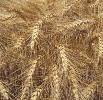
You can drive for several miles in some parts of Indiana and not find a wheat field of young wheat, just beginning to green up fro spring. A few fields were spotted in the Huntington area last week on a trip to the celebration signing of the 25th certified livestock producer, Pete Eschelman, Heritage Farms. And there are some wheat fields in southwest Indiana where doublecrop soybeans after wheat is normally a staple corp. However, even there, there aren't as many wheat fields as normal.
By mid-November 2009, Chuck Mansfield, Purdue University Extension agronomist based at Vincennes University, knew wheat acreage was down. "There wasn't a lot of enthusiasm anyway after so-so yields and disease problems," he notes. "Then it was a wet fall and it was hard to get the crop in on time. Many fields just didn't get planted."
Numbers from the Indiana Ag Statistics Service bear out the drop in wheat acreage. It shows that Indiana farmers planted 300,000 acres of wheat last fall, down 36% from the previous year, when 470,000 acres were planted. The five year average before this year's acreage is included was 460,000 acres.
The good news is the condition of the wheat that is out there, notes Herb Ohm, USDA plant breeder and interim head of the Purdue Agronomy Department. "The wheat looks good so far this year," he says. "There is not as much wheat planted this year, but the wheat that is planted looks fine."
Ohm says that the wheat is in good shape, even though many of the fields that were planted from Lafayette south didn't go in until late October or early November due to rain and wet soils. "It has come through fine," he observes.
The next hurdle is possible cold spells this late in the season, or this early in the spring, depending upon your point of view. A severe cold snap could damage the flower head, Ohm acknowledges, but the wheat itself should be fine.
"If a cold spell happens, which there is a 90% chance it won't, then there isn't much farmers can do except hope the nights don't get too cold," he says.
At least one commercial weather service is calling for one more blast of cold air, possible with snow, through this region before winter retreats permanently and it turns into a warmer than normal April.
Regardless of planting issues in 2009, wheat harvest should happen on schedule in 2010, Ohm concludes.
About the Author(s)
You May Also Like




